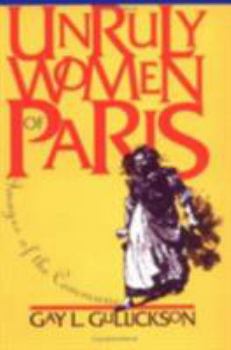Unruly Women of Paris: Images of the Commune
Select Format
Select Condition 
Book Overview
In this vividly written and amply illustrated book, Gay L. Gullickson analyzes the representations of women who were part of the insurrection known as the Paris Commune. The uprising and its bloody suppression by the French army is still one of the most hotly debated episodes in modern history. Especially controversial was the role played by women, whose prominent place among the Communards shocked many commentators and spawned the legend of the pétroleuses, women who were accused of burning the city during the battle that ended the Commune. In the midst of the turmoil that shook Paris, the media distinguished women for their cruelty and rage. The Paris-Journal , for example, raved: "Madness seems to possess them; one sees them, their hair down like furies, throwing boiling oil, furniture, paving stones, on the soldiers." Gullickson explores the significance of the images created by journalists, memoirists, and political commentators, and elaborated by latter-day historians and political thinkers. The pétroleuse is the most notorious figure to emerge from the Commune, but the literature depicts the Communardes in other guises, too: the innocent victim, the scandalous orator, the Amazon warrior, and the ministering angel, among others. Gullickson argues that these caricatures played an important role in conveying and evoking moral condemnation of the Commune. More important, they reveal the gender conceptualizations that structured, limited, and assigned meaning to women as political actors for the balance of the nineteenth and well into the twentieth century.
Format:Paperback
Language:English
ISBN:0801483182
ISBN13:9780801483189
Release Date:December 1996
Publisher:Cornell University Press
Length:304 Pages
Weight:0.93 lbs.
Dimensions:0.6" x 6.0" x 8.9"
Age Range:18 years and up
Grade Range:Postsecondary and higher
Customer Reviews
1 rating
Interesting take on the Commune
Published by Thriftbooks.com User , 15 years ago
There are many good things to say Gay Gullickson's book on the Paris Commune. She makes a sound, coherent argument, and provides all the necessary background on the topic, which many monographs fail to do. If you know nothing about the Commune, you can still read this book because Gullickson covers the history in enough detail to prepare you for her arguments. Since the actual events of the Commune in 1871, the women involved in the uprising have been portrayed negatively. Women were not supposed to be involved in politics and were expected to confine themselves to family duties, so many men -- particularly of the bourgeoisie -- were outraged by their participation in revolutionary activities. As a result, men slandered these women, and those perceptions not only stuck for decades, but they seemed to intensify. Gullickson gets to the root of these misconceptions and points out the hypocrisies and flaws. She also shows how Commune sympathizers and opponents sought to create far different representations of these women, meaning that at least one side, and probably both, were inaccurate. On the negative side, Gullickson is repetitive in this book and occasionally seems surprised at the way women were viewed in 1871, even though, sadly, these images of women lasted well into the next century. The book is easy to read and easy to follow. It's recommended for anyone interested in European history, and if you're assigned this book for a class, consider yourself fortunate.






